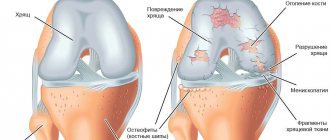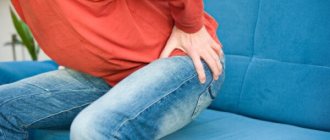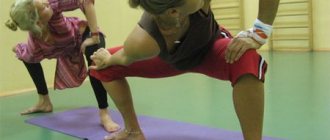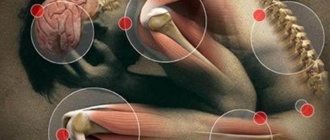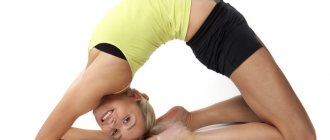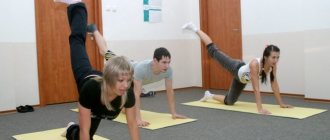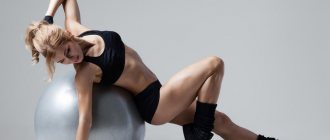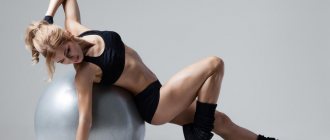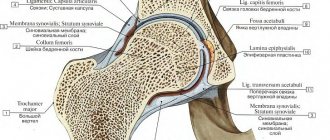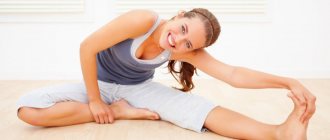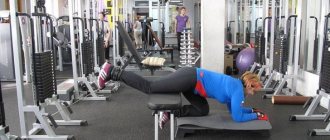Joints in the human body are a very important, but very vulnerable component, which should be paid the closest attention throughout life, except perhaps in infancy. They allow us to move and are constantly under high load. This is especially true for the hip joint, which supports the weight of the entire body. It is not surprising that it begins to “fail” over time. The defeat of this joint can provide a person with crutches, or even bed rest until the very end of his life. Dr. Bubnovsky will help you avoid these undesirable situations: the exercises for the hip joint developed by him are considered by many doctors to be the most effective method for combating coxarthrosis.
Symptoms, causes, stages
According to medical statistics, coxarthrosis accounts for approximately forty percent of all joint diseases. It mainly affects women; the dangerous disease begins to develop in middle age. Most often the disease affects only one side of the pelvis, but if left untreated it can become bilateral.
With coxarthrosis, a decrease in cartilage tissue in the joint leads to stiffness of movement, walking causes noticeable pain, and an unpleasant crunching sound is heard in the pelvic area. As the pathology develops, the pain becomes constant, haunting the patient even during rest or sleep. The limb is visually shortened, and further progression of the disease can result in ankylosis - the formation of adhesions in the joint, which will make it almost immobile.
The risk of developing coxarthrosis is increased by the following factors:
- obesity, which increases the pressure of total body weight on a specific joint;
- injuries, especially not fully treated;
- flat feet;
- endocrine pathologies.
Coxarthrosis can affect even professional athletes who constantly load the hip joint - runners, football players, weightlifters.
Despite the danger of the disease, it can be stopped while maintaining freedom of movement if you perform exercises for the hip joint according to Bubnovsky. And the sooner alarming symptoms are noticed, the sooner the practice of therapeutic exercises begins, the more successful the treatment will be.
Treatment of coxarthrosis
After diagnosis and accurate diagnosis, the patient is prescribed a treatment program. As a rule, it includes several techniques:
- drug therapy;
- traditional medicine;
- dietary nutrition;
- physiotherapeutic procedures;
- exercise therapy;
- massage and manual therapy;
- surgical intervention (endoprosthetics);
- preventive methods of coxarthrosis diseases.
The use of medications is combined with the Bubnovsky technique for coxarthrosis of the hip joints.
The course of drug treatment will include the following drugs:
- Chondroprotectors. Restore cartilage tissue of joints. Chondroprotectors include drugs such as: Artra, Glucosamine, Artroflex, etc.
- Non-steroidal anti-inflammatory drugs that relieve pain and inflammation of the joint. NSAIDs include: Indomethacin, Diclofenac, Ibuprofen, etc.
- Muscle relaxants. Reduce the tone and spasm of skeletal muscles (Flexen, Meprotan, Sirdalud, etc.).
- Corticosteroids. Hormonal drugs that are injected into the joint.
- Vascular agents that improve blood circulation in the pelvic joints (Trental, Nikoshpan, etc.).
- Compresses for pain relief using medical bile, Dimexide and other means. Ointments are used to relieve swelling and inflammation.
The physiotherapeutic course includes: ultrasound, electrophoresis and magnetic therapy.
General recommendations
When developing exercises for the hip joint, Bubnovsky took into account the peculiarities of the course of joint diseases in his methodology and strongly advises patients to take into account some quite important points when performing gymnastics:
- When performing each exercise, be sure to monitor your breathing . It should be deep and measured. Proper breathing saturates the blood with sufficient oxygen: it circulates better, supplying cells with nutrients, which contributes to the rapid restoration of joints;
- pay close attention to your body's signals. If any exercise causes discomfort, and even more so unpleasant painful sensations, it should be done in a more gentle manner or completely abandon the practice before consulting with your doctor;
- the load on the joint should increase gradually and in stages . At first, each exercise is performed at least several times; their number increases no more than once a week, but no more than two or three approaches;
- do not do gymnastics by force . If the frequency of repetitions causes resistance from the body, it needs to be reduced somewhat. Bubnovsky considers the motto of any exercise for arthrosis of the hip joint to be “Joy, not pain”;
- Gymnastics should be done every day , regularly, without skipping. The only acceptable reason to refuse exercise is poor general health (for example, high fever due to the flu or other viral diseases). It may take you more than one month to get positive dynamics. But perseverance pays off in the retreat of pain, the return of the ability to move normally and take care of oneself independently;
- After performing exercises, many patients experience cramps in the leg muscles. This is a normal reaction of an unprepared body; it does not require giving up gymnastics. Cramps are eliminated by self-massage, and with continued exercise they stop appearing;
- Over time, the work needs to involve first the knee joints, and then the ankle joints – in combination.
The main thing is to believe in success and maintain a fighting spirit. Dejection and defeatist thoughts reduce the effectiveness of the exercises performed.
Gymnastics for the hip joints according to Bubnovsky does not require special physical training from the patient. However, you need to approach it wisely, as with any stress on the body. That is, before classes you should do a good warm-up to warm up your muscles. In addition, the hip joint area needs a preliminary massage. You can make it yourself; A physiotherapist or professional massage therapist will show you the basic approaches.
A warm shower can also be recommended: it stimulates blood circulation and relaxes muscles. If you have such an opportunity, do swimming in parallel with gymnastics. If not, get into the habit of walking in the fresh air for at least an hour every day. At first at a slow pace, as the joint recovers - at a more active pace.
Correct breathing
In order for the Bubnovsky complex to give the expected effect for coxarthrosis and other diseases, you need to not only move correctly, but also breathe. The author has developed a method of diaphragmatic breathing. To use not only the bronchi, but also the diaphragm, you need to pronounce the sound “HA” as you exhale. Basic principles of adaptive breathing in kinesitherapy:
- any forceful actions (traction, bench press) are performed while exhaling, reverse movements without effort - while inhaling;
- when performing strength exercises, you need to exhale briefly, quietly, when doing cleansing breathing, the exhalation is also short, but explosive, and stretching exercises should be accompanied by a long exhalation of low tones;
- exhaling, you need to concentrate on the pain point, as if heating the source of pain with your breath;
Stretching should begin with relaxing the facial muscles. They should not be distorted by a grimace of pain. Following the face, the shoulder girdle and back relax.
Basic complex
Exercises for the hip joint according to Bubnovsky are performed while lying on your back, smoothly, without sudden movements. The following are considered universal, suitable for different courses of coxarthrosis:
- the leg bends at the knee, the arms clasp it, the leg is pulled towards the chest (it is advisable for the knee to rest against it). You need to hold this position for at least 4 seconds. If at first it is too difficult, do not force the body, but try to slowly reach the desired time period. Then the leg, again with the hands, is carefully lowered to the floor, and the exercise is done with the second limb;
- for the second exercise you need to straighten your legs. One of them rises to an angle of 45-60 degrees. Do not bend your knee, do the movement slowly. The same exercise is repeated with the other leg;
- still lying on your back, bend both legs, knees spread as wide as possible. You are unlikely to be able to put them on the floor, you don’t need to strive for this, but the distance between the knees should increase a little every day;
- in a supine position, the lower limbs are bent at the knees, the arms are placed along the body, palms down. The leg should be slowly extended, as if overcoming resistance. Ideally, it should straighten all the way. Then, at the same pace, the foot returns to its place;
- the starting position is the same, the knees are bent again, but the feet are placed at some distance from each other, approximately shoulder width apart. The knees bend to the side one by one. The patient should strive to touch the floor with them. In this case, the pelvis should not come off the surface or move;
- the last exercise in the complex. The legs are bent at the knees, the patient lies on his back. You need to lift your head and the back of your head off the floor and reach your knees with your forehead. Do not lift your feet from the surface, do not pull your legs towards your head.
In itself, gymnastics for the hip joints according to Bubnovsky is not difficult, but at first, many patients find the exercises very difficult. There is no need to rush, get upset or despair. Regular training will give results, and you will be able to reach your knee with your forehead and place your knee on the floor.
Hip joint: brief description
A joint is a movable formation that unites several bones of the skeleton. The articular apparatus unites the bones of the skeleton into a single whole and ensures their smooth movement.
Reference . About 180 different joints provide human mobility.
The hip joints are large joint formations in the human body. They are formed by the acetabulum of the pelvic bones and the heads of the femurs.
These elements at the points of contact are covered with cartilage, which smoothes movements, absorbs stress and prevents wear of bone tissue.
The hip joints provide movements : external - internal rotation, flexion - extension, abduction - adduction.
Read also: Exercises for osteoarthritis
These formations are exposed to enormous stress every day, so pathological processes develop in them most often.
Reference. Lesions of the hip joint take first place among diseases of the articular apparatus.
Diseases affecting this joint formation include coxarthrosis, coxitis, aseptic necrosis, and dysplasia.
Next, we will consider the features of the treatment of coxarthrosis according to Bubnovsky, as well as types of exercises.
After endoprosthetics
It is not always possible to avoid surgery. Some patients sought help late; for others, conservative treatment simply did not help. The last chance to maintain mobility is surgery. Bubnovsky himself once went through prosthetics and developed exercises aimed at restoring the functioning of the hip joint after surgery:
- Sitting on a stool or chair, you need to bend over, reaching your toes with your fingers. Pay attention to the correct seat height: the hips should be positioned strictly horizontally, the knees should be bent clearly at a right angle;
- standing and holding onto a support (for example, the back of a chair), make careful, non-sharp swings of your leg forward/backward, left/right. Increase amplitude every day.
With constant practice of such gymnastics, pain is reduced, blood circulation in the affected joint is improved, and the elasticity of the ligaments is increased.
Contraindications
Like any physical education in general and therapeutic exercise in particular, gymnastics for the hip joints according to Bubnovsky is not allowed to everyone and not at any time. So, for heart pathologies, the complex requires permission from a cardiologist . You may have to give up some exercises. It is sometimes necessary to interrupt gymnastics during severe exacerbations of the disease, especially those accompanied by intense pain. You can return to exercise after the inflammation has subsided; in this case, you need to start at a more gentle pace, with a decrease in the number of options performed.
Women during the premenstrual period should approach gymnastics more carefully, especially if their bleeding is severe and accompanied by painful sensations. During delicate days, it is recommended to reduce the intensity of exercise even for those women whose menstruation is quite easy.
Dr. Bubnovsky’s complex does not completely restore the functionality of the joint. It gradually pumps up the muscles and trains the periarticular tissues. Gymnastics is simple, safe and accessible for independent performance; supervision from an instructor is not required. But if you are unsure about the correctness of the exercises or find some of them inappropriate, start exercising under the supervision of a physiotherapist.
The essence of the technique, its features
With stagnation of blood, injury, or the accumulation of a large amount of fluid in the joint, edema occurs, against the background of which most of the channels (pores) through which synovial fluid is filtered are reduced or obstructed. Exercise according to Dr. Bubnovsky is aimed at reducing post-inflammatory consequences by accelerating blood flow and maintaining synovial synthesis.
At the moment of muscle contraction, during physiological movements in the joint, reserves of joint fluid are released, thereby provoking the secretion of its new portions. Against this background, the amount of fluid in the joint cavity changes, the load on the cartilage when walking decreases, pain decreases and the range of motion increases.
With constant maintenance of normal blood flow, the pH of the intracellular and intercellular fluid of the joint tissue changes. This allows you to speed up the processes of intracellular metabolism and reduce the irritability of nerve fibers. As a result, there is a decrease in stiffness in the morning and an increase in exercise tolerance.
The peculiarity of joint exercises according to Bubnovsky is that you do not need to use any other drugs or conservative therapy to treat joints. The therapeutic effect occurs solely due to correct, physiological movements.
Professor Bubnovsky has developed more than 10 different methods of joint gymnastics and exercises for all joints of the human body. At the heart of his works, Bubnovsky takes into account the fact that with all diseases of the joints, thinning of the cartilage layer occurs. Because of this, the exercise technique is based on movements with minimal pressure on the articular cartilage.
Not only gymnastics
Bubnovsky points out that it is impossible to get rid of problems with the hip joint with exercises alone, even if performed regularly and diligently. A radical revision of the diet is required.
Cartilage tissue responds very gratefully to the introduction of coarsely ground cereals to the menu. Healthy joints require phosphorus and a number of minerals - they can be obtained by eating offal and seafood.
But products made from white flour will have to be excluded from the menu completely. Exactly the same as peeled cereals and semolina. You can eat bread, but in limited quantities and always contain bran. Oatmeal, buckwheat, and pearl barley are highly recommended.
To prevent cartilage from being destroyed and the joint from deforming, you need to consume fermented milk products in large quantities. Fatty broths and smoked meats are prohibited; meat can be purchased from lean varieties or poultry. Various mushroom and vegetable decoctions are very useful for joint diseases. The daily presence of fresh vegetable salads on the menu is approved. It is better to season them with vegetable oil, ideally olive oil.
Salt and sugar are also subject to restrictions. Salt provokes swelling in the area of the affected joint. Instead of sugar, it is better to use natural honey if you are not allergic to bee products.
The diet should be even more strict for overweight patients. They will definitely have to get serious about losing weight. And not only because obesity prevents you from performing high-quality exercises for the hip joint according to Bubnovsky, but also because the excess load will continue to destroy the cartilage, causing further deformation of the joint.
